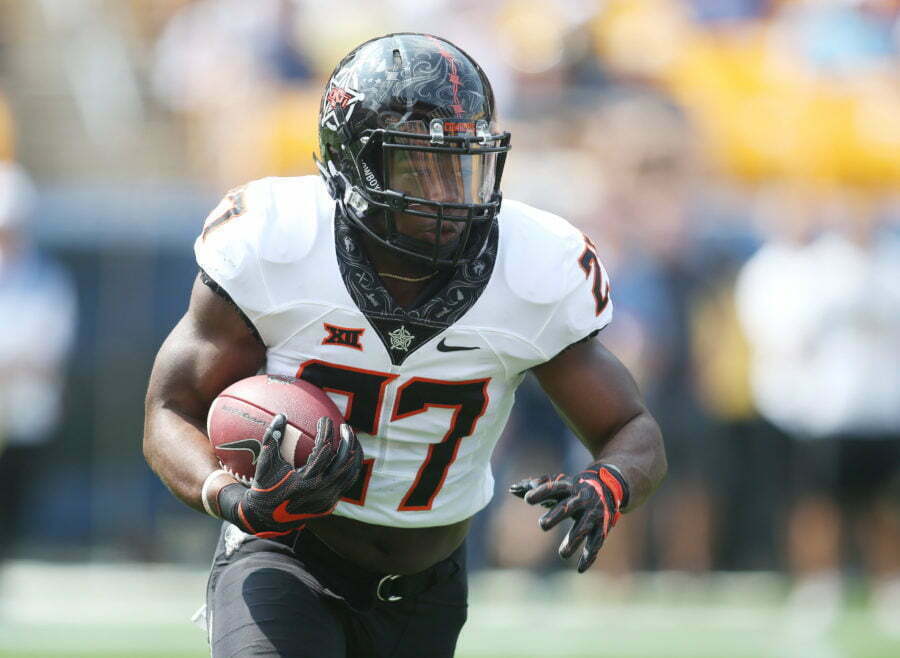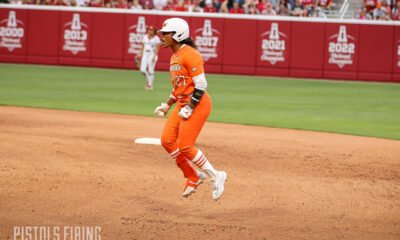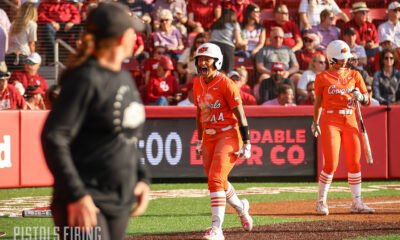Football
Line Segment: Pass Protection Better Than You Thought on Saturday

Oklahoma State thoroughly dominated Pitt in just about every area this past Saturday, and that was consistent with what I saw upon taking another look at the offensive and defensive line performance on film as well. All of my observations are from about 2.5 quarters, before most of the backups came in.
Coming into the game I knew that OSU would be able to have success through the air, but I was expecting them to have a lot of issues running the ball well. Pat Narduzzi’s quarters coverage scheme is notorious for loading up to stop the run, and that was certainly the case last year in Stillwater.
One thing to keep in mind is Pat Narduzzi’s defensive scheme is designed to keep as many people in the box as possible to stop the run, then defensive assignments are designated in coverage based off WR depth and location.
This includes bringing a variety of blitzes and different types of pressure. Generally the safeties in this scheme sit no more than 8 yards off the line of scrimmage. You have to take this into consideration when evaluating run blocking and pass protection, knowing that some plays you will be at a disadvantage numbers-wise.
Last week, the discussion was mainly focused on Oklahoma State’s run blocking, and although that was a factor here it seems most people were concerned with the pass protection this week. This has a lot to do with the fact that Pitt keeps a lot of guys around the line of scrimmage, and also bring a lot of pressure.
I actually think the offensive line held up pretty well in pass protection. I had 19 clean pockets in 22 true dropbacks for Mason Rudolph. The line officially gave up 1 sack, that wasn’t their fault (will show below). Also Pitt was credited with 11 QB hurries, which is a lot, but I was only able to find 6. It’s possible several came from the back half of 3rd quarter and 4th quarter when I stopped watching.
Zach Crabtree went down in the first half and Tevin Jenkins was able to come in and fill in nicely. It’s really impressive that he was able to play left guard (last week vs. USA) and right tackle this week. There is a huge difference in those two positions, and Jenkins handled it well. It’s a huge asset to have a quality backup who can play multiple positions.
Here are some examples of some good and bad line play.
Here is a clean pocket for Rudolph against a 4-man front. I saw a lot of this.
This is the one credited sack. Knowing that you’re on the 4-yard line and standing in the end zone, you have to know to get the ball out quicker than this. Also Rudolph panics a little bit in the pocket, he was actually in a much better position if he didn’t move after his drop, and once he stepped up he actually created a lane for the DE to make the sack. Really solid defense by Pitt though, took away check down and primary read.
Aaron Cochran is beat around the edge for the QB hurry. Tremendous pocket presence and movement by Rudolph to avoid the sack.
Lundblade and Keyes are beat outside here for the QB hurry.
The run game was very effective in the first half, although the final box score doesn’t necessarily support that. Since the pass game was having so much success, there weren’t a lot of opportunities for the run game. Justice Hill averaged 8.3 yards/carry and was so good in the open field.
Here is a huge hole for Hill. Check out Larry Williams at RG clearing the hole and extending his block 8-9 yards down the field.
However, here’s Williams gettnig beat on outside move for a short gain on the ground.
The offensive line regularly faced 7-8 defenders in the box vs. Pitt, and held up pretty well.
Offensive Observations
• While watching the OU Ohio State game last weekend, I noticed a play a really liked that was run by OU. I jokingly tweeted Mike Yurcich saying he should take a look.
@Coach_Yurcich ???? https://t.co/HZM8CoTeBI
— Adam Lunt (@AdamLunt817) September 12, 2017
I happened to notice that a play that is eerily similar to this one showed up 4 times in the game vs. Pitt. Mike, are you listening right now? If so please don’t read the comments, a lot of people want you fired for some reason. Keep up the good work!
Back on track here. The play design from the OU game is called Counter Trey Swing Read. The part that makes it unique is pulling two OL from backside (thus counter-trey), or in their case one OL and one H-back. They also add a WR in motion. In this play Baker pulls the ball and throws to the motioning WR who beats man coverage easily on the edge. It’s a really great play design.
Oklahoma State ran four plays (two of which went for touchdowns) that have a very similar concept, and actually ended up having four different results. The main difference being they’re doing it from a 4-WR set and pulling the tackle and guard. Here are the different variations.
On this play you can see the pulling backside lineman, and a built in bubble screen. There is no jet sweep on this play, but there will be on others below. The pulling OL and play action are just enough to hold the safety long enough for Stoner to find space in the seam.
Same play, but this time it’s a WR screen this time.
This time you see a jet sweep. Again, watch the play-side LBs and safeties hesitate for just a moment because they’re watching the OL pull to the strong side. This gives Stoner enough time to find some space down the sideline.
Same play here, fake jet sweep and let Justice Hill do his thing. This was a few minutes after the jet sweep with Stoner. Watch the flow of the safety and the 2 LBs crash in on Stoner because of what happened previously.
You can see how each play is designed to draw you one direction and take the play the opposite way, also each play is setting up the one that follows it. Really cool play design, might have had some inspiration assistance from our friends down south.

-

 Wrestling2 days ago
Wrestling2 days agoOSU Wrestling: 2020 Olympic Gold Medalist David Taylor Named Head Coach of Cowboy Wrestling
-

 Football3 days ago
Football3 days agoOklahoma Transfer Gavin Freeman Commits to Oklahoma State
-

 Softball4 days ago
Softball4 days agoOSU Softball: Cowgirls Secure Bedlam Series Win with 6-2 Victory against Sooners
-

 Softball3 days ago
Softball3 days agoOSU Softball: Big 12 Releases Tournament Bracket with Cowgirls as No. 3 Seed






